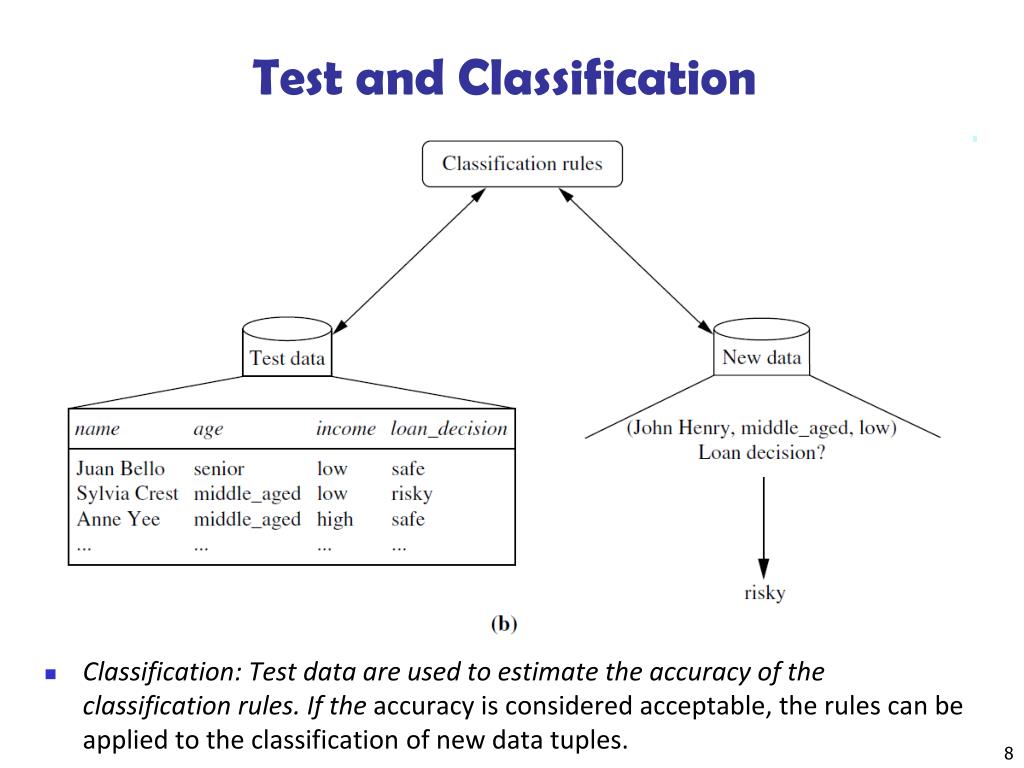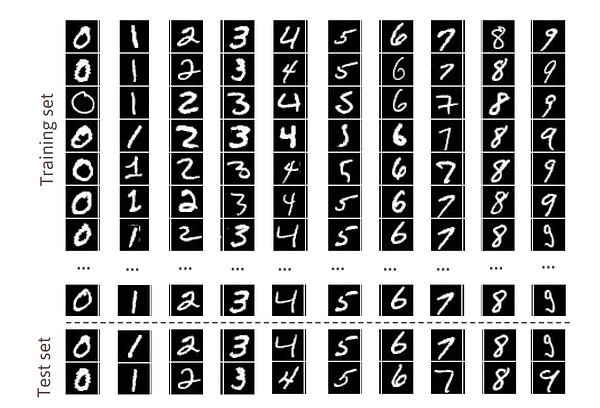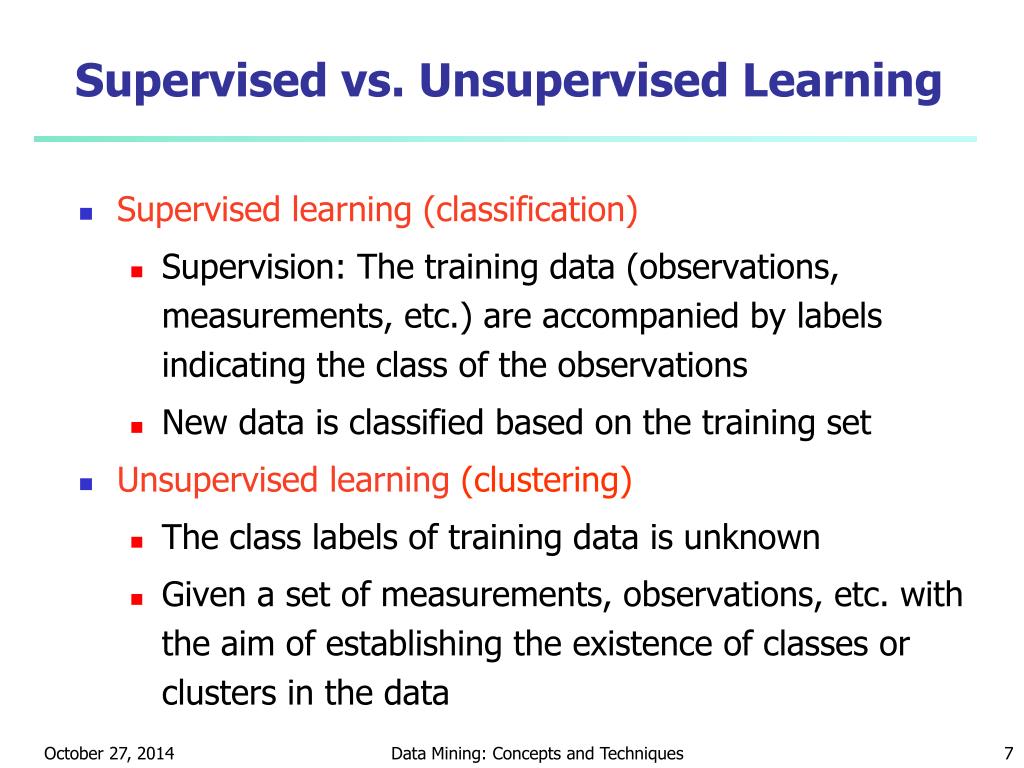44 in supervised learning class labels of the training samples are known
Supervised Machine Learning: What is, Algorithms with Examples Supervised Machine Learning is an algorithm that learns from labeled training data to help you predict outcomes for unforeseen data. In Supervised learning, you train the machine using data that is well "labeled." It means some data is already tagged with correct answers. It can be compared to learning in the presence of a supervisor or a teacher. Supervised learning - Wikipedia Supervised learning is the machine learning task of learning a function that maps an input to an output based on example input-output pairs. It infers a function from labeled training data consisting of a set of training examples. In supervised learning, each example is a pair consisting of an input object and a desired output value. A supervised learning algorithm analyzes the training data and produces an inferred function, which can be used for mapping new examples. An optimal scenario will a
What is Supervised Learning? - SearchEnterpriseAI What is supervised learning? Supervised learning is an approach to creating artificial intelligence (), where a computer algorithm is trained on input data that has been labeled for a particular output.The model is trained until it can detect the underlying patterns and relationships between the input data and the output labels, enabling it to yield accurate labeling results when presented ...

In supervised learning class labels of the training samples are known
Supervised Vs. Unsupervised Learning In Machine Learning ... The formal supervised learning process involves input variables, which we call (X), and an output variable, which we call (Y). We use an algorithm to learn the mapping function from the input to the output. In simple mathematics, the output (Y) is a dependent variable of input (X) as illustrated by: Y = f (X) Unsupervised Learning and Data Clustering | by Sanatan ... Supervised Learning: The system is presented with example inputs and their desired outputs, given by a "teacher", and the goal is to learn a general rule that maps inputs to outputs. Unsupervised Learning: No labels are given to the learning algorithm, leaving it on its own to find structure in its input. Unsupervised learning can be a goal in itself (discovering hidden patterns in data) or a means towards an end (feature learning). Unstructured Data Classification.txt - In Supervised ... In Supervised learning, class labels of the training samples are Known Select pre-processing techniques from the options All the options A classifer that can compute using numeric as well as categorical values is Random Forest Classifier Classification where each data is mapped to more than one class is called Multi-class Classification TF-IDF is a freature extraction technique
In supervised learning class labels of the training samples are known. Supervised vs. Unsupervised Learning: What's the ... - IBM What is supervised learning? Supervised learning is a machine learning approach that's defined by its use of labeled datasets. These datasets are designed to train or "supervise" algorithms into classifying data or predicting outcomes accurately. Using labeled inputs and outputs, the model can measure its accuracy and learn over time. supervised learning and labels - Data Science Stack Exchange The main difference between supervised and unsupervised learning is the following: In supervised learning you have a set of labelled data, meaning that you have the values of the inputs and the outputs. What you try to achieve with machine learning is to find the true relationship between them, what we usually call the model in math. There are many different algorithms in machine learning that allow you to obtain a model of the data. In supervised learning, class labels of the training ... This involves learning a function that maps an input to an output based on input-output pairs. In supervised learning, class labels of the training samples are known. A supervised learning algorithm, therefore, analyzes the training samples and produces an inferred function that can then help us map new examples. Supervised Learning in Absence of Accurate Class Labels Measuring complexity of systems is very important in Cybernetics. An aging human heart has a lower complexity than that of a younger one indicating a higher risk of cardiovascular diseases, pseudo-random sequences used in secure information storage
Supervised Learning - an overview | ScienceDirect Topics 3.1 Definition of supervised learning. Supervised Learning [20] is an important form of ML. It is named as supervised, because the learning process is done under the seen label of observation variables; in contrast, in Unsupervised Learning, the response variables are not available. In Supervised Learning, datasets are trained with the training sets to build ML, and then will be used to label new observations from the testing set. In supervised learning, class labels of the training ... In supervised learning, class labels of the training samples are "known." The correct answer is "known." The other options for the question were "unknown," "partially known," and "doesn't matter." It cannot be "unknown," because training samples must be known. PDF Supervised Learning: Classificaon - Supervision: The training data (observaons, measurements, etc.) are accompanied by labels indicang the class of the observaons - New data is classified based on the training set • Unsupervised learning (clustering) - The class labels of training data is unknown - Given a set of measurements, observaons, etc. with the aim of establishing the existence of classes or clusters in the data What is Supervised Learning? Supervised learning, one of the most used methods in ML, takes both training data (also called data samples) and its associated output (also called labels or responses) during the training process. The major goal of supervised learning methods is to learn the association between input training data and their labels.
116 questions with answers in SUPERVISED LEARNING ... The most popular sort of machine learning method is supervised learning, which requires data and annotated labels to train. Supervised learning involves training the system using well-labeled data. [PDF] Inductive Semi-supervised Multi-Label Learning with ... In multi-label learning, each training example is associated with multiple class labels and the task is to learn a mapping from the feature space to the power set of label space. It is generally demanding and time-consuming to obtain labels for training examples, especially for multi-label learning task where a number of class labels need to be annotated for the instance. Class labels, descriptions, and the number of training ... Download Table | Class labels, descriptions, and the number of training samples (#tr) for the 23classes of the LCVF data set. from publication: GENERALIZED RELEVANCE LEARNING VECTOR QUANTIZATION ... Supervised learning: predicting an output variable from ... The problem solved in supervised learning. Supervised learning consists in learning the link between two datasets: the observed data X and an external variable y that we are trying to predict, usually called "target" or "labels". Most often, y is a 1D array of length n_samples. All supervised estimators in scikit-learn implement a fit(X, y) method to fit the model and a predict(X ...
A Gentle Introduction to Self-Training and Semi-Supervised ... In supervised learning, this data must be labeled with respect to the target class — otherwise, these algorithms wouldn't be able to learn the relationships between the independent and target variables. However, there are a couple of issues that arise when building large, labeled data sets for classification: Labeling data can be time-consuming.

PPT - Data Mining: Concepts and Techniques (3 rd ed.) — Chapter 8 — PowerPoint Presentation - ID ...
Lecture 1: Supervised Learning - Cornell University Let us formalize the supervised machine learning setup. Our training data comes in pairs of inputs ( x, y), where x ∈ R d is the input instance and y its label. The entire training data is denoted as. D = { ( x 1, y 1), …, ( x n, y n) } ⊆ R d × C. where: R d is the d-dimensional feature space. x i is the input vector of the i t h sample.
Types Of Machine Learning: Supervised Vs Unsupervised Learning Supervised learning is learning with the help of labeled data. The ML algorithms are fed with a training dataset in which for every input data the output is known, to predict future outcomes. This model is highly accurate and fast, but it requires high expertise and time to build. Also, these models require rebuilding if the data changes.
Supervised and Unsupervised learning - GeeksforGeeks Supervised learning is classified into two categories of algorithms: Classification: A classification problem is when the output variable is a category, such as "Red" or "blue" , "disease" or "no disease". Regression: A regression problem is when the output variable is a real value, such as "dollars" or "weight".
3 Examples of Supervised Learning - Simplicable 3 Examples of Supervised Learning. John Spacey, May 03, 2017. Supervised learning is an approach to machine learning that is based on training data that includes expected answers. An artificial intelligence uses the data to build general models that map the data to the correct answer. The following are illustrative examples.
What is Supervised Learning? - IBM Supervised learning, also known as supervised machine learning, is a subcategory of machine learning and artificial intelligence. It is defined by its use of labeled datasets to train algorithms that to classify data or predict outcomes accurately. As input data is fed into the model, it adjusts its weights until the model has been fitted ...

Inverse Problems in Geodynamics Using Machine Learning Algorithms - Shahnas - 2018 - Journal of ...
Supervised Machine Learning Classification: An In-Depth ... Supervised Learning. In supervised learning, algorithms learn from labeled data. After understanding the data, the algorithm determines which label should be given to new data by associating patterns to the unlabeled new data. Supervised learning can be divided into two categories: classification and regression.
ML | Types of Learning - Supervised Learning - GeeksforGeeks Supervised Learning : Supervised learning is when the model is getting trained on a labelled dataset. A labelled dataset is one that has both input and output parameters. In this type of learning both training and validation, datasets are labelled as shown in the figures below. Both the above figures have labelled data set -





Post a Comment for "44 in supervised learning class labels of the training samples are known"